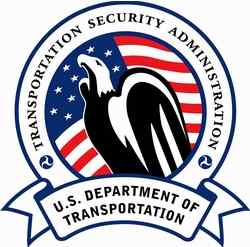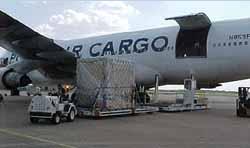Foreign All-Cargo Carriers to Meet Higher Security
Standards
 The TSA has issued a new security
directive that will require random inspection of air cargo
and to require foreign all-cargo air carriers to comply with the
same cargo security procedures that domestic air carriers must
follow. Passenger aircraft that carry cargo and all-cargo
planes, both foreign and domestic, will be subject to the random
inspections on flights within, into, and out of the U.S.
Inspections will be done by the carriers. TSA will ensure that
inspections are completed properly.
The TSA has issued a new security
directive that will require random inspection of air cargo
and to require foreign all-cargo air carriers to comply with the
same cargo security procedures that domestic air carriers must
follow. Passenger aircraft that carry cargo and all-cargo
planes, both foreign and domestic, will be subject to the random
inspections on flights within, into, and out of the U.S.
Inspections will be done by the carriers. TSA will ensure that
inspections are completed properly.
Foreign all-cargo air carriers operating into and out of the
United States also will be required to follow security plans
approved by TSA which detail procedures for screening. In addition,
plans will verify the identities of persons with access to planes
and ensure the security of parked aircraft. The directives also
outline reporting requirements for foreign air carriers should
potential threats arise.
“These new requirements constitute important steps in our
efforts to have the best possible protection for air cargo,”
said Homeland Security Secretary Tom Ridge. "Furthermore, these
actions constitute the building blocks of a comprehensive approach
that will significantly enhance air cargo security.”
Issuance of these requirements is an interim step in the
implementation of TSA’s broader Air Cargo Strategic Plan that
employs a layered approach to securing critical elements of the
entire air cargo supply chain. Incorporating a threat-based risk
management approach similar to that used in the maritime cargo
environment by the Homeland Security’s Customs and Border
Protection, this plan commits to ensuring all cargo deemed
“higher risk” is inspected.

The plan responds to comments made in September 2003 by working
groups of TSA’s Aviation Security Advisory Committee, as well
as recommendations from the General Accounting Office and the
Department of Transportation’s Office of Inspector General.
The Strategic Plan will be supported by a Notice of Proposed Rule
Making and will accompany security programs and initiatives.
The first main objective of the Strategic Plan calls for
augmentation of TSA’s Known Shipper Program, which prohibits
air carriers from accepting cargo that does not originate from
shippers who meet TSA’s Known Shipper requirements. The plan
provides for full deployment of the program’s Known Shipper
Automated Database and Indirect Air Carrier Database, which will
allow TSA and air carriers to have faster access and thorough
information on applicants for Known Shipper status and those
seeking to ship cargo aboard passenger aircraft.
 A second component of the Strategic
Plan is the development of a cargo pre-screening system similar to
that used at our nation’s borders. TSA will use terrorist
watch lists and federal and commercial databases to identify
suspicious or higher risk shipments. From this they will develop a
“risk score” for cargo shipments. TSA is working
closely with Customs and Border Protection to build on existing
pre-screening technology in place in the maritime environment.
A second component of the Strategic
Plan is the development of a cargo pre-screening system similar to
that used at our nation’s borders. TSA will use terrorist
watch lists and federal and commercial databases to identify
suspicious or higher risk shipments. From this they will develop a
“risk score” for cargo shipments. TSA is working
closely with Customs and Border Protection to build on existing
pre-screening technology in place in the maritime environment.
TSA will accelerate research and development of technological
solutions and new inspections protocols for inspecting air cargo as
the third component of its Strategic Plan. Using $55 million
provided in fiscal year 2004, TSA will assess the viability of
using Explosive Detection Systems, currently used to screen
passenger baggage, or other systems that might have the potential
to detect threats in air cargo.
Technology development efforts will be augmented by deployment
of canines in the cargo environment for the development of new
inspections protocols. TSA is conducting pilot programs using
canine teams to inspect certain classes of mail at 11 airports and
in the inspection of general cargo at six airports.
TSA’s Strategic Plan focuses on strategies to secure air
cargo perimeters, facilities, equipment and personnel. Enhanced
background checks on persons who have access to cargo or cargo
aircraft and required screening of passengers aboard cargo planes
are among many measures that will be adopted.
 ANN's Daily Aero-Term (04.26.24): DETRESFA (Distress Phrase)
ANN's Daily Aero-Term (04.26.24): DETRESFA (Distress Phrase) ANN's Daily Aero-Linx (04.26.24)
ANN's Daily Aero-Linx (04.26.24) Airborne 04.22.24: Rotor X Worsens, Airport Fees 4 FNB?, USMC Drone Pilot
Airborne 04.22.24: Rotor X Worsens, Airport Fees 4 FNB?, USMC Drone Pilot Airborne 04.24.24: INTEGRAL E, Elixir USA, M700 RVSM
Airborne 04.24.24: INTEGRAL E, Elixir USA, M700 RVSM Airborne-NextGen 04.23.24: UAVOS UVH 170, magni650 Engine, World eVTOL Directory
Airborne-NextGen 04.23.24: UAVOS UVH 170, magni650 Engine, World eVTOL Directory





